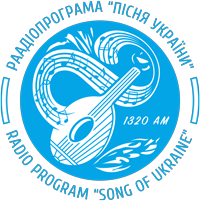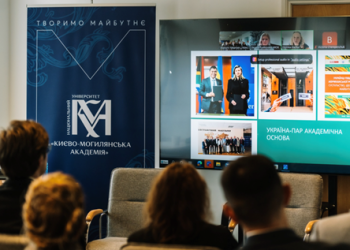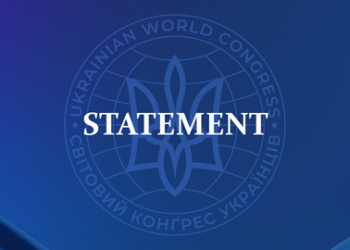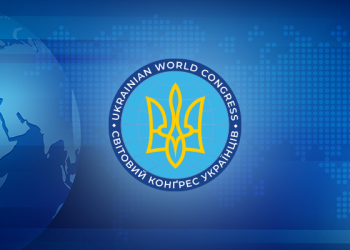The Canadian Association of Ukrainians of the Former Yugoslavia (CAUFY) organized a party-presentation of the new book Songs of the Old Country, on Thursday, February 20, 2025, in the parish hall of St. Volodymyr’s Ukrainian Catholic Church in Edmonton. This useful and unexpectedly interesting book was compiled by Mykhailo Lyakhovych from Toronto, together with Felix Figuryk. The publisher of the book is the Ukrainian community of the Republic of Croatia and the Ukrainian Cultural and Educational Society named after Ivan Franko in the city of Vukovar. The book was published with the support of the Council for National Minorities of the Republic of Croatia and the Ministry of Science and Education of the Republic of Croatia. The editorial team included the author Mykhailo Lyakhovych, Mykhailo Gutsman and Felix Figuryk. The cover was designed by Mykhailo Gutsman.
Songs of the Old Country is a collection of folk songs by Ukrainians from Croatia, Bosnia-Herzegovina, and Serbia. These songs reflect one aspect of Ukraine’s cultural heritage, preserved by a people who have been scattered around the world for over 130 years. No matter where Ukrainians settled, they found ways to preserve their identity and culture, despite incredibly difficult economic circumstances, discrimination, and pressures to assimilate. As the author wrote, songs were “…perhaps the only golden thread that connected them to Ukraine.”
Ukrainian Resettlement
For Ukrainian Canadians, the story of the first settlers who came from Ukrainian lands to far western Canada is well known. Unfortunately, we sometimes forget how other Ukrainian immigrants of the 20th century, whether to Canada, Brazil, or the countries of the former Yugoslavia, faced great difficulties and challenges. Songs of the Old Country are a small window that allows us to see the experiences of Ukrainian immigrants to the Balkans. As author Mykhailo Lyakhovych writes in his foreword: “…despite the difficult fate, the Ukrainians of Bosnia, Croatia, and Vojvodina managed to preserve their ancestral faith, their national consciousness, and folk art.”
A word from the author
Volodymyr Boychuk, an active member of the community, a long-time teacher in the Ukrainian bilingual program, and a lover of Ukrainian music and culture, introduced Mykhailo Lyakhovych. Volodymyr Boychuk wrote his master’s thesis on the topic: “Conclusions – Ukrainian Songs of Bosnia,” and that is why the guest’s presentation was very apt
Mykhailo Lyakhovich told why and how this book was born. His interest in the folk art of Ukrainians in Bosnia, Croatia and Vojvodina began in his student years, when Lyakhovich became fascinated with Ukrainian dances and folklore. It was then that the author realized “that this small branch of the Ukrainian diaspora also has a rich folklore, has original folk art, which until then no one had systematically collected and recorded”.
The author believes that his collection of folk songs will not satisfy the high criteria of scientific work. On the contrary, this collection is a sincere, truthful and unpretentious collection of folk art, such as it existed, full of feeling and love for the native land and preserving the uniqueness and spirit of its creators. The songs that Ukrainians composed and sang in the former Yugoslavia healed their spiritual pain, expressed their experiences, joy and disappointment, hopes and dreams, longing for their homeland and respect for their people. They record human experiences through the eyes of a Ukrainian immigrant in a foreign, unknown and often unwelcoming place.
As the author said, he began recording songs from his mother and later collected from other, older people who knew and remembered the songs of their people. Almost all of those from whom the songs were recorded were born in the late 19th and early 20th centuries, and only one person was born in Ukraine. All the others were already born in the former Yugoslavia. The author said that it was impossible to record all the melodies, so many of the songs in the collection only have text. The photographs presented in the book are very interesting. Together with the songs, these photos throw the reader into ancient times. They say that “a picture is worth a thousand words” and it would have been very helpful if more photographs had been included in this book.
The songs in the collection are organized by theme. The first is the Haivky. Mykhailo Lyakhovych claims that this is the oldest form of Ukrainian song, dating back to pre-Christian times. These were songs about spring, prosperity and life. Next are the Vivady, or wedding choruses, which were performed during the rite of giving. Then there are the Wedding Choruses and then the Jocular Songs. Next is a group of songs called Zhovnirski and Rekrutski. These songs are very interesting because Ukrainians were mobilized into the Austro-Hungarian army, because these lands belonged to the Austrian Empire. In these songs you can feel sadness, pain and disappointment, as in “a soldier came out and saddled his horse. And the girl wept with pity”.
The next two groups of songs, although very short, show us that the Ukrainian immigrants preserved what they knew about the history of the Ukrainian people. Historical songs and Cossack songs celebrate events and some famous historical figures.
Songs about Love are presented in a separate group and then come the Romances. As Lyakhovych explained, Romances are original songs, original melodies, words and expressions, in form
and are different in vocabulary from folk songs.
More than forty songs are included in the group of Everyday Songs, which describe life and everyday difficulties. The last four groups of songs include the Riflemen and Cossack Songs, Kolomyyka (of which there were a great many) and a group of undefined different themes. Among these, the Riflemen Songs are very interesting, because the question arises – how did they reach Bosnia? Mr. Lyakhovych explained that students from Galicia who studied in Zagreb could not return to Lviv and spent their summer vacations in Bosnia. They brought singers with them and Ukrainianized the population.
An interesting two-page Informant pays tribute to all who shared their knowledge of Ukrainian songs, because they were the voices who preserved the knowledge of our common past and passed on to us the treasure of their creativity.
A Moment in the History of the Ukrainian Diaspora
It should be noted that these songs are like a photograph that captures a historical moment in Ukrainian culture. Although some songs, at first glance, are familiar, after reading the words, we see that they are not familiar. The themes of love, separation, hope and sadness are universal, but the expressions that we read in the songs are ancient, reflecting an ancient period of the Ukrainian language and the history of our diaspora. If someone remembers the expressions or speech of their grandparents who were born in the early years of the twentieth century, then the vocabulary of the songs will be familiar.
Historical archival photo exhibition
The presentation included an extensive exhibition of photographs that document the life of Ukrainians in the vicinity of settlements, such as Bosnia, Serbia, etc. All the photographs have great historical value. They are silent witnesses to the lives of Ukrainians who built church communities, preserved their religious and cultural customs, and built a new, better life. The photographs show how hardworking and dedicated our settlers were in their efforts to build a successful personal and public life, all the while preserving their Ukrainian identity. They founded schools, choirs, dance ensembles, drama clubs, educational societies, reading rooms, and even “founded a self-help savings bank.”
Mykhailo Liakhovych explained that the Prosvita society, which was founded in Zagreb, Serbia, by political emigrants from Galicia and Volhynia and some figures of the Ukrainian People’s Republic (UNR), was of exceptional importance for the preservation of the national consciousness of Bosnian Ukrainians. These individuals Ukrainized and raised awareness in the Ukrainian settlements of Bosnia. Through the work of such educators, national consciousness and love for their homeland, Ukraine, took root. All these efforts, along with other social factors, were crowned with success, because the assimilation of Ukrainians was slowed down and Ukrainian communities flourished and existed for many decades. The economic pressure after World War II and then the terrible war in 1991 had an irreversible impact on the Ukrainian community. The author explains that this war “… was a cruel blow to the Ukrainian diaspora in the Balkans. It flared up with the greatest fury precisely where Ukrainians lived in larger communities…”.
Cultural and artistic program
The evening’s program was led by Ilya Symchyshyn, head of the KUKU. He thanked the organizations that help KUCU, including the Ukrainian Canadian Congress, the Alberta Foundation for the Advancement of Ukrainian Education, the Ukrainian Catholic Brotherhood, the St. Volodymyr Ukrainian Catholic Parish, and the St. Elijah Ukrainian Orthodox Parish.
The atmosphere of the evening was warm, welcoming, and friendly. Guests came from various parts of the Ukrainian community. The collected voluntary donations are intended for Bridge of Hope, a project that collaborates with the Edmonton Diocese and the Sisters of the Servants of the Immaculate Virgin Mary in Lviv. The sisters run a dormitory for girls in need. Bridge of Hope also helps underprivileged children who are victims of unfortunate circumstances, where parents are at war, have died, or are ill. Marianne Doblanco briefly spoke about Bridge of Hope, which began its work more than 25 years ago. Volunteers Daniel Kowalczyk and Wanda Kowalczyk provided more information about this important project.
A group of students from the Ivan Franko Ukrainian Studies Course in Edmonton energetically performed songs from the book. Under the guidance of Ola Myts, director of the Ukrainian Native School in Edmonton, Marko Myts, Natalka Struk, Sofia Lytvynets, Anna Prykuda, and Yaroslav Romanchak participated. Ivan Freyuk accompanied on the accordion.
Dr. Andriy Gornyatkevych, a renowned academician, former professor at the University of Alberta, and bandura player, performed two pieces on the bandura, which he introduced before the performance.
Mariyka Lepka performed two moving songs. As the singer said, one song told about fate and separation, and the second reminded us of Ukrainians far from us, who are fighting against an enemy that is destroying the land and life. The musical accompaniment on the accordion was performed by Ivan Freyuk.
Two singing duets by young performers Anna and Mariyka Levita and Katrusia and Pavlo Bandyak were lovely performances.
Mykhailo Lyakhovych also sang several songs from the collection and played the ancient bandura.
A Gift to the People, Readers, and Scholars
The Preface and Afterword are important parts of the work. In the Preface, the reader is introduced to the history of Ukrainian immigration to Bosnia, the challenges, the development of the community, and the connections with Metropolitan Andrei Sheptytsky. The Afterword is completely different, of a personal nature, which connects all the material, touching on the reasons that prompted the author to work. Here, the spiritual values that have supported the Ukrainian people for centuries are manifested, along with a description of the difficult circumstances of the immigrants’ lives.
The only remarks that can be made to Songs of the Old Country are that the Preface is only in Ukrainian and Croatian, and the Afterword is only in Ukrainian. In today’s world, where English is the universal language, this very useful material would be more accessible to a wider range of readers if it were presented in English translation. The history and geography of the territories of the former Yugoslavia are little known to the average reader. Two or three maps showing these lands during the Austrian Empire, then in the interwar period, and today’s state borders would be very useful to the reader. Interestingly, the circulation of the book, 500 copies, is modest. It would be good if a copy of this collection were in libraries that have collections about the Ukrainian diaspora and the history of our communities.
This collection of songs is of great value in terms of folk art, the history of the Ukrainian diaspora, in this case Ukrainian immigrants to the former Yugoslavia, and the cultural achievements of this “…the smallest branch of the Ukrainian diaspora, which managed to survive in difficult historical circumstances and preserve its language, culture, and folk art to this day.” These songs are evidence of “love for its distant, secret, never-seen Ukraine.”
Lida M. Vasylyn,
League of Ukrainian Women of Canada, Edmonton Branch













